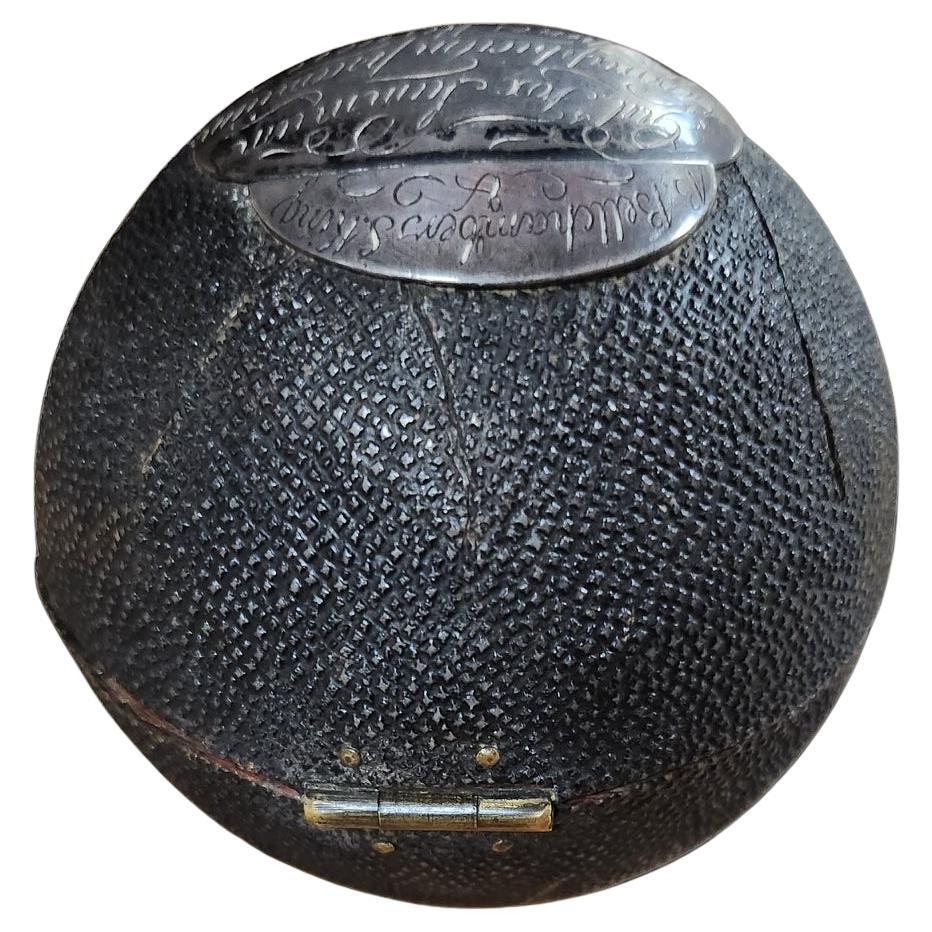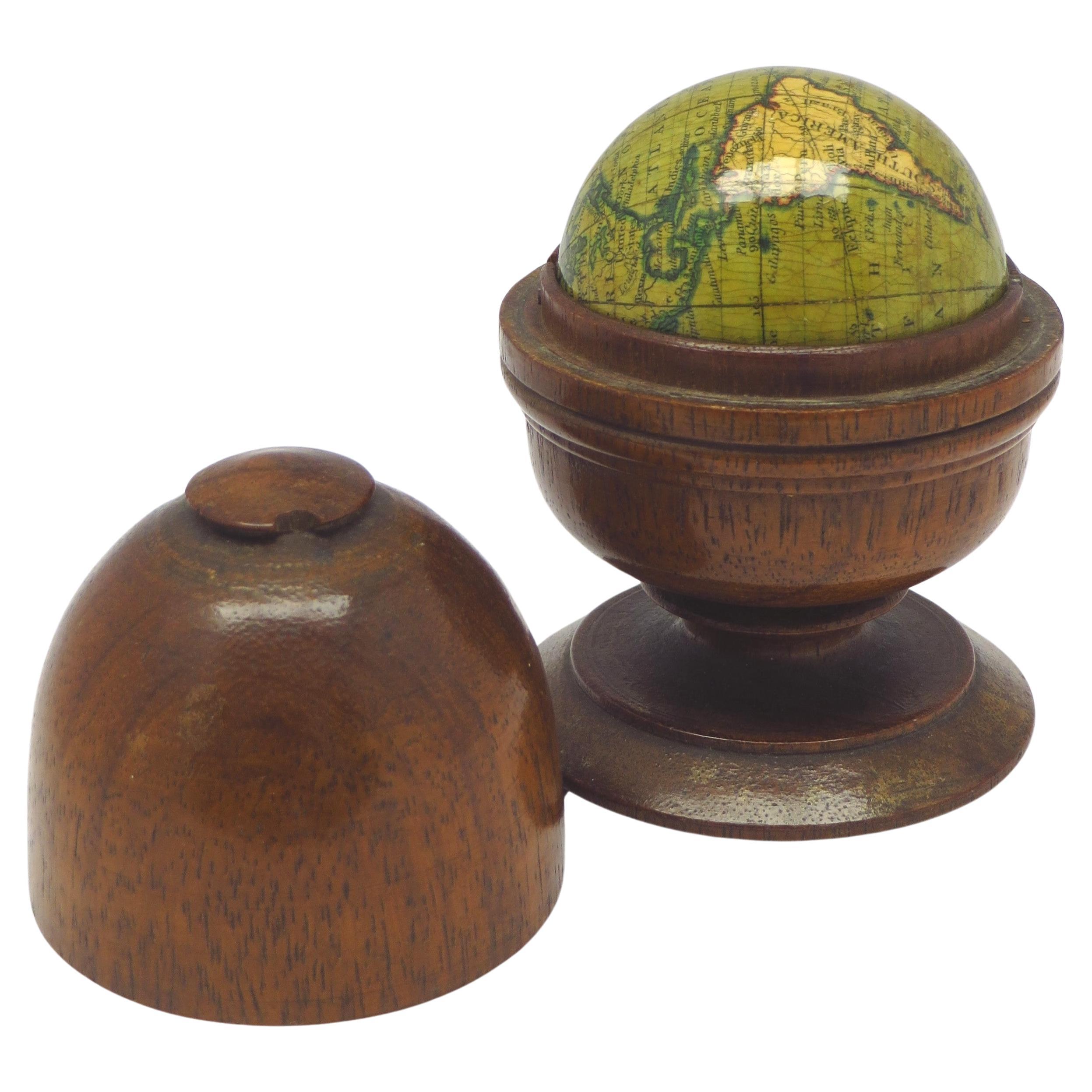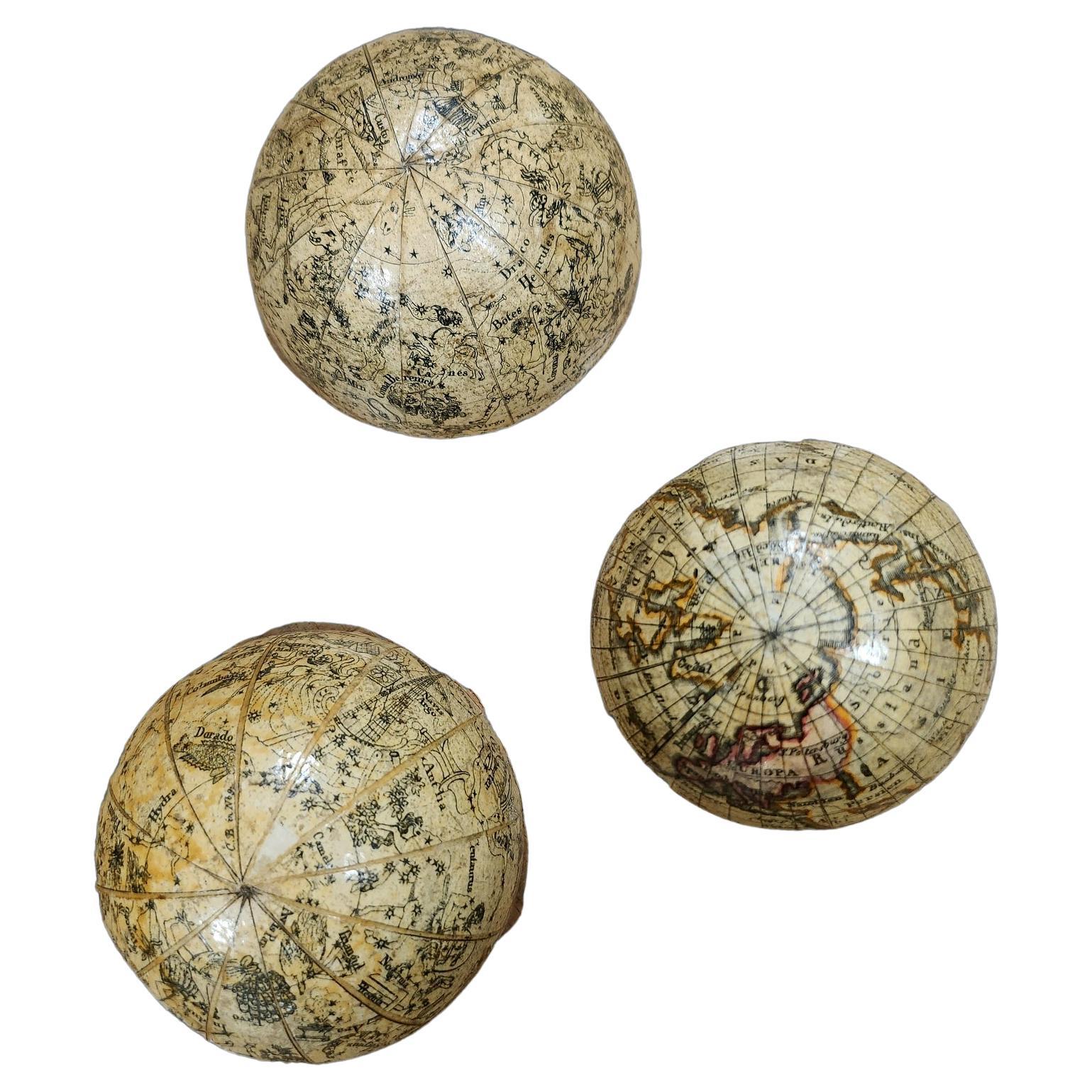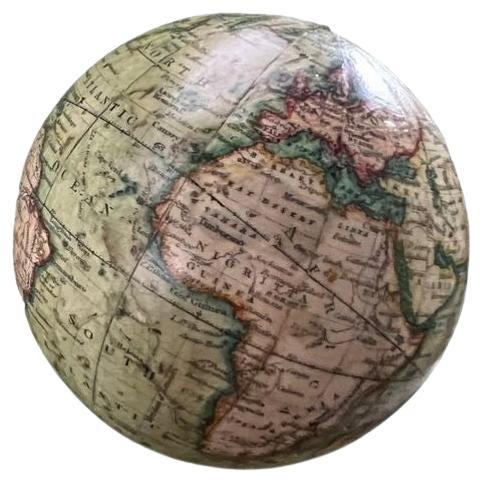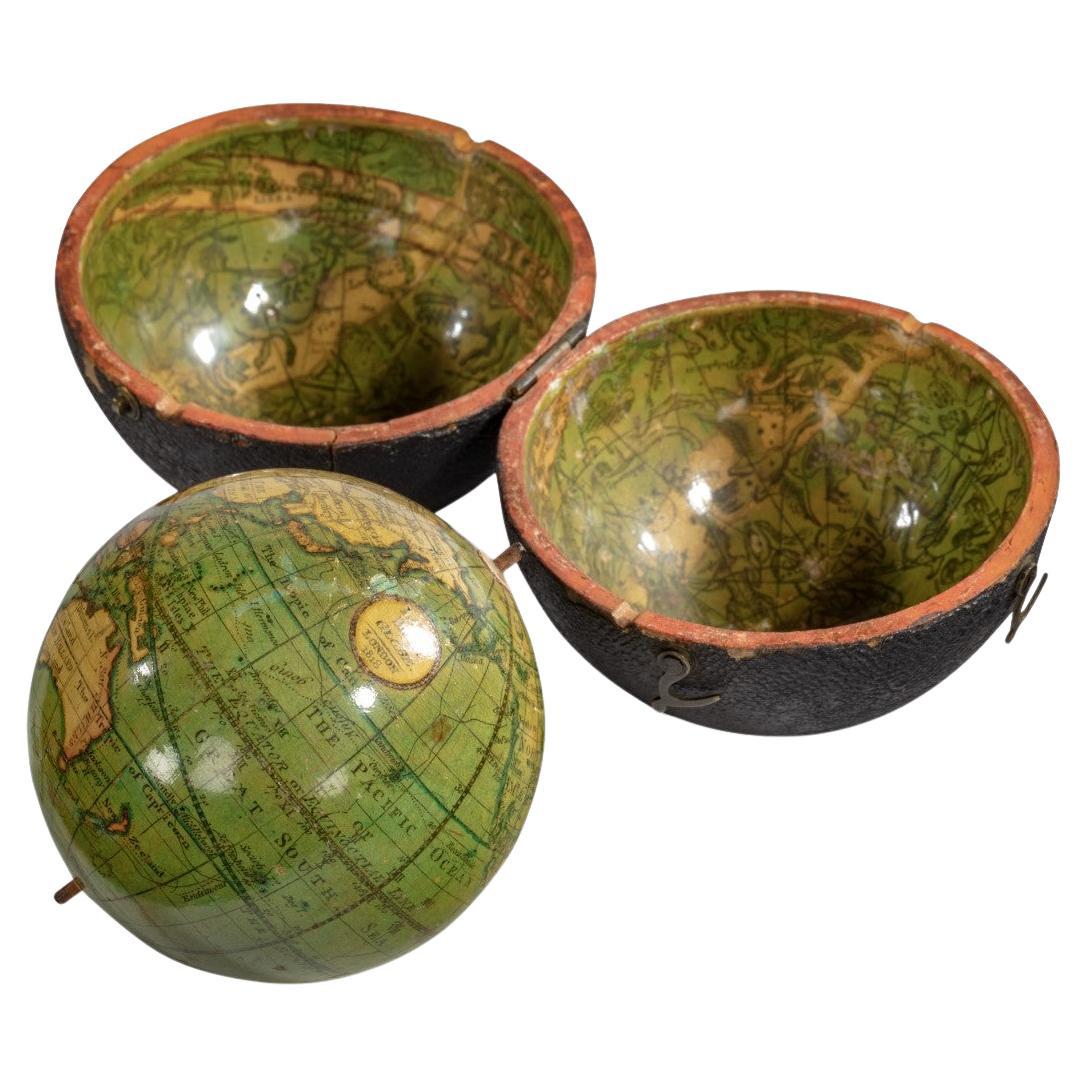Items Similar to Miniature pocket globe in colourful card box
Want more images or videos?
Request additional images or videos from the seller
1 of 12
Miniature pocket globe in colourful card box
About the Item
Miniature terrestrial pocket globe. Model of the earth.
London, 1857 by J. Manning
diameter of 1,75 inches / 4,5 cm.
This lovely miniature terrestrial globe consists of twelve copper engraved, hand coloured gores over a wooden base. The gores are varnished. The colouring is both subtle and original. With a central pin contained in a colourful card box.
A little about miniature globes: The miniature or pocket globe was a British invention, introduced to the world by Joseph Moxon in 1673 when he produced a 3-inch globe. To own a pocket globe is to have the whole world in miniature. Pocket globes were never to be taken very seriously – they never served any practical purpose; their size makes accurate calculations impossible, and they tend to lack the rings and dials for most common manipulations. No, they were seen more as a status symbol, or a lovely decorative artistic artefact to reside on a gentleman’s desk or small table. There is a school of thought that some of the cheaper pocket globes may have aided children’s education. Today, they reflect a lost and never-to-be-forgotten age of exploration and discovery. The heyday or peak time for the pocket globe was the late 18th century.
- Creator:Michael Manning (Maker)
- Dimensions:Height: 2 in (5.08 cm)Diameter: 1.75 in (4.45 cm)
- Style:Early Victorian (Of the Period)
- Materials and Techniques:
- Place of Origin:
- Period:
- Date of Manufacture:1857
- Condition:Repaired: card box restored. Wear consistent with age and use.
- Seller Location:ZWIJNDRECHT, NL
- Reference Number:1stDibs: LU9419239073662
About the Seller
New to 1stDibs
Joined in the past six months.
No Reviews Yet
Vetted Seller
These experienced sellers undergo a comprehensive evaluation by our team of in-house experts.
1stDibs seller since 2023
- ShippingRetrieving quote...Ships From: ZWIJNDRECHT, Netherlands
- Return PolicyA return for this item may be initiated within 14 days of delivery.
More From This SellerView All
- A truly delightful miniature terrestrial pocket globeBy Nathaniel MillsLocated in ZWIJNDRECHT, NLA truly delightful miniature terrestrial pocket globe in a celestial case, 3 inches / 6.8 cm. The globe consists of 12 wonderful varnished, engraved hand-coloured gores that stretch from pole to pole. In the original case of black fish-skin with a brass hinge and two brass hook-and-eyelet closures, case with a unique silver plaque which reads: "B. Bellchamber S. King - Gul's Fox Summum Geographicum Praemium Pares Meruere". * [This very roughly translates to:] "B. Bellchamber S. King - Gul's Fox Earns Top Geographical Peers Award". *Is it too much to suppose and speculate that this wonderful silver plaque attached to the outer case is in recognition of a [geographic?] scholastic achievement? The prize awarded to the lucky recipients (B. Bellchamber & S. King?) is this globe? This terrestrial globe has two repairs; to the area concerning the British Isles, and also to parts of Europe and Scandinavia (with some loss). There is some slight loss to a portion of North America, and there is a crack to the northern portion of South America. It is partly worn in other places and has some slight spotting. It is lacking the axis metal pin, and the two holes that normally allow for this pin have been closed. The case is split and segmented, partly rubbed and worn with cracks, (as is usual.) The case will close. There is some minor chipping and cracking to the outer rim of the inside of the case. About Pocket Globes. It is generally thought that Joseph Moxon brought pocket globes to England in the late seventeenth century. These globes usually consist of a terrestrial sphere of about 7.5 cm in diameter that fits into an outer case (usually made of fish-skin). The interior of this case often bears bright, colourful celestial cartography, so you effectively have the celestial heavens surrounding the terrestrial earth. Pocket globes, although highly desirable, are for all intents and purposes somewhat impractical, as their size makes accurate calculations impossible. Few, if any, pocket globes came with accompanying booklets, so it is hard for anyone to know who used them and for what purposes. Pocket globes could simply have served purely as status symbols for wealthy gentlemen, who had an interest in geography or astronomy. The fields of geography and the sciences were quickly advancing during this period. Alternatively, pocket globes could be seen as a tool used in children’s education, especially when you think that they are construction from cheap materials such as papier-mâché. Points of Interest. This particular globe shows California as a peninsula, whereas previously it had been depicted as an island – a misconception dating back to the sixteenth century; it has the northwest coast of America simply as "unknown parts."; - due to a profound lack of knowledge of the region; the track of Admiral George Anson’s circumnavigation of the world (1740-44) is drawn – Anson led a squadron of eight ships on a mission to disrupt or capture the Pacific Ocean possessions of the Spanish Empire, for emphases, the trade winds are indicated by red arrows. There are three large lakes engraved in Africa that may longer exist. The Celestial Gores. The celestial gores, housed within the case, are fun and eye-catching both in their display and in their content. Constellations and both hemispheres and are represented. Gemini, Cancer, Virgo, Orion, Andromeda, Taurus, Leo, Ursa Major etc in the north, and Scorpio, Libra, Canis Major etc in the south. A celestial globe is a mapping of the stars, and has been used since classical times. Celestial globes were first used by Greek astronomers, and later by the Islamic world, where the earliest known globes date from the eleventh century. The stars were thought to sit on the surface of a giant sphere around the earth, and the constant movement of the stars each night and throughout the year appeared to be caused by this giant sphere slowly turning overhead. In line with its counterpart, the terrestrial globe, celestial globes are mapped by a north and a south pole, an equator, and lines of latitude and longitude. The Terrestrial Globe. The North Pole encompasses the Arctic Circle, Baffin Bay (Canada), Iceland, Greenland, northern Siberia and Nuova Zembla. Europe shows the Dominion of Muscovy (a principality of the late Middle Ages centered on Moscow), Turkey, the British Isles, Italy etc. Africa highlights the Barbary coast, Biledulgerid (a former country in North Africa), the Zaara Desart (Sahara Desert), Negroland (an archaic term in European mapping referring to large portions of West Africa), Guinea, Ethiopia, Congo, the islands of the Azores and the Canaries. Australia (New Holland) shows the outdated cartography of an incomplete coastline; The West Australian and Northern Territory coastlines are in full, however, there is no connected mainland coastline from South Australia up to Northern Queensland. Papua New Guinea is still thought to be a part of the Australian mainland. A portion of Tasmania’s coastline is engraved. The only places/regions mentioned are: Dimens Land and Carpentaria in the north; Lewins, St. Francis, Mary’s Island, South Cape, and Dimens Land in the south. Interestingly, a place named Hartog’s Island is mentioned off the West Australian coast. This island has a unique place within Australia’s history as it is the first recorded European landing on Australian soil in 1616 by the island’s namesake, Dutch captain Dirk Hartog...Category
Antique Mid-18th Century British Dutch Colonial Globes
MaterialsOther
- Miniature globe in aturned and stained beechBy Newton and SonLocated in ZWIJNDRECHT, NLNewton & Son pocket globe London, 1838 Miniature terrestrial globe with a diameter of 2 inches / 5 cm. In a turned and stained beech two-section case, 3,95 inches / 10 cm. high.Category
Antique 19th Century British Late Victorian Globes
MaterialsFruitwood, Paper
- Fine double pocket globeBy Carl BauerLocated in ZWIJNDRECHT, NLPublisher: Carl Bauer (Germany, 1780-1857) Place / Date: Nürnberg, ca. 1840 Size: Diameter Globes 6,5 cm. Terrestrial and celestial "Mother and Child" or double globe; the ...Category
Antique 1840s German Dutch Colonial Globes
MaterialsWood, Paper
- A fine pair of miniature globes on standsBy Karl MullerLocated in ZWIJNDRECHT, NLA rare pair of miniature terrestrial and celestial globes. by K. Müller, 1822 Karlsruhe, Germany Diameter globes: 7 cm. Total high: 14,5 cm. Each with 12 hand-coloured engraved p...Category
Antique Early 19th Century German International Style Globes
MaterialsHardwood, Paper
- An extremely rare pair of miniature globes by Johann Baptist HomannBy Johann Baptist HomannLocated in ZWIJNDRECHT, NLJ.H. Homann (Germany, 1664-1724) Nürnberg, after 1715 Globus Terrestris [and] Globus Celestis. juxtu observationes Parisienses Regia Academia Scientiarum constructus [and] juxtu observationes Parisienses Regia Academia Scientiarum constructus. Nuremberg, [after 1715]. Original stands by Homann Heirs, [after 1730]. An extremely rare pair of terrestrial and celestial globes, each with 12 hand-coloured engraved paper gores, over a papier mâché and plaster sphere, each globe with papier mâché meridian ring, mounted on horizon rings with a handwritten number VIII and III on each globe. The horizon rings supported by four quadrants with text "Zu finden in Nürnberg / wohnhaft unter der Vesten / bey denen Homaenischen Erben/ dem Prediger Klöster gegenüber", both globes on a turned single wooden black stand. Diameter 64 mm (2.5 inches), height 185 mm. RARE. Johann Baptist Homann (1664–1724), a German geographer and cartographer. He founded a publishing business in Nürnberg in 1702, and published his first atlas in 1707, becoming a member of the Academy of Sciences in Berlin in the same year. Homann was appointed Imperial Geographer to Charles VI in 1715 and became the most important map...Category
Antique 1710s German Dutch Colonial Globes
MaterialsOther
- A decorative pair of rare table globes in a fine condition.By Johann Gabriel DoppelmayrLocated in ZWIJNDRECHT, NLThese pair of globes, dated 1730, are original and in fine condition. Title: Globus terrestris novus Loca Terrae insigniora sec. praestant Astron. et Geogr. observationes sistens op...Category
Antique Early 18th Century German Baroque Globes
MaterialsOther
You May Also Like
- 19th Century German Miniature Pocket Terrestrial GlobeBy C. Abel-KlingerLocated in Essex, MAA miniature 19th century 3.5 inch diameter pocket terrestrial globe by C. Abel-Klinger, Nuremberg, Germany, in English for the English speaking markets. Signed with cartouche reading...Category
Antique 1880s German Scientific Instruments
MaterialsBrass
- Newton and Son Pocket Globe and CaseBy Newton and SonLocated in Spencertown, NYThe terrestrial globe is 3 inches in diameter contained within a turned mahogany box with cover. The seas in light green and land masses in darker green. Dimension of Globe 3" Diame...Category
Antique Mid-19th Century English Victorian Globes
MaterialsFruitwood, Paper
- Regency Lane’s Pocket Globe, Dated 1818By Lane'sLocated in Lymington, HampshireA 3 ½ inch Regency Lane’s pocket globe, dated 1818, the terrestrial globe with the seas in light green and the land masses outlined in darker green, contained within a hinged black shagreen case, the concave interior of the case applied with the engraved celestial charts...Category
Antique 1810s English Regency Globes
MaterialsWood
- English Pocket Globe, London, Circa 1775-1798By Herman MollLocated in Milano, ITPocket globe London, between 1775 and 1798 Re-edition of the globe of Hermann Moll (1678-1732) dated 1719 The globe is contained in its original case, which itself is covered in sh...Category
Antique Late 18th Century English George III Globes
MaterialsShagreen, Paper
- Pocket Globe by Nathaniel Hill, London 1754Located in Milano, ITNathaniel Hill Pocket globe London, 1754 The globe is contained in its original case, which itself is covered in shark skin. There are slight gaps in the original paint on the sphere. The case no longer closes. The sphere measures 2.6 in (6.8 cm) in diameter whereas the case measures 2.9 in (7.4 cm) in diameter. lb 0.24 (kg 0.11) The globe is made up of twelve printed paper gores aligned and glued to the sphere. In the North Pacific Ocean there is a scroll with the inscription: A New terrestrial Globe by Nath. Hill, 1754. The celestial globe is depicted on the inside of the box. On the terrestrial globe much of central and southern Africa is empty. North America bears only the name of some British colonies. It shows California as a peninsula and the northwest coast of America as "unknown parts" (Alaska is not described and is only partially delineated; it would become part of the United States in 1867). The route of Admiral Anson is traced (1740) and the trade winds are indicated by arrows. Australia, still named New Holland (the new name would be introduced in 1829), is part of the west coast. (See Van der Krogt, P., Old Globes in the Netherlands, Utrecht 1984, p. 146 and Van der Krogt, P. - Dekker, E., Globes from the Western World, London 1993, p. 115.) Nathaniel Hill (London, news from 1746 to 1768) had impeccable professional credentials: he had done his apprenticeship with Richard Cushee, who at the time was carrying out surveying work for John Senex's Surrey map...Category
Antique 1750s English George II Globes
MaterialsShagreen, Paper
- George III Pocket Globe After Herman MollBy Herman MollLocated in Lymington, HampshireA 3 inch George III pocket globe after Herman Moll, the terrestrial globe inscribed in a cartouche ‘A correct globe with the new discoveries’ and fitted within a hinged black shagreen case, the concave interior of the case applied with the engraved celestial charts...Category
Antique 1770s English George III Globes
MaterialsWood
